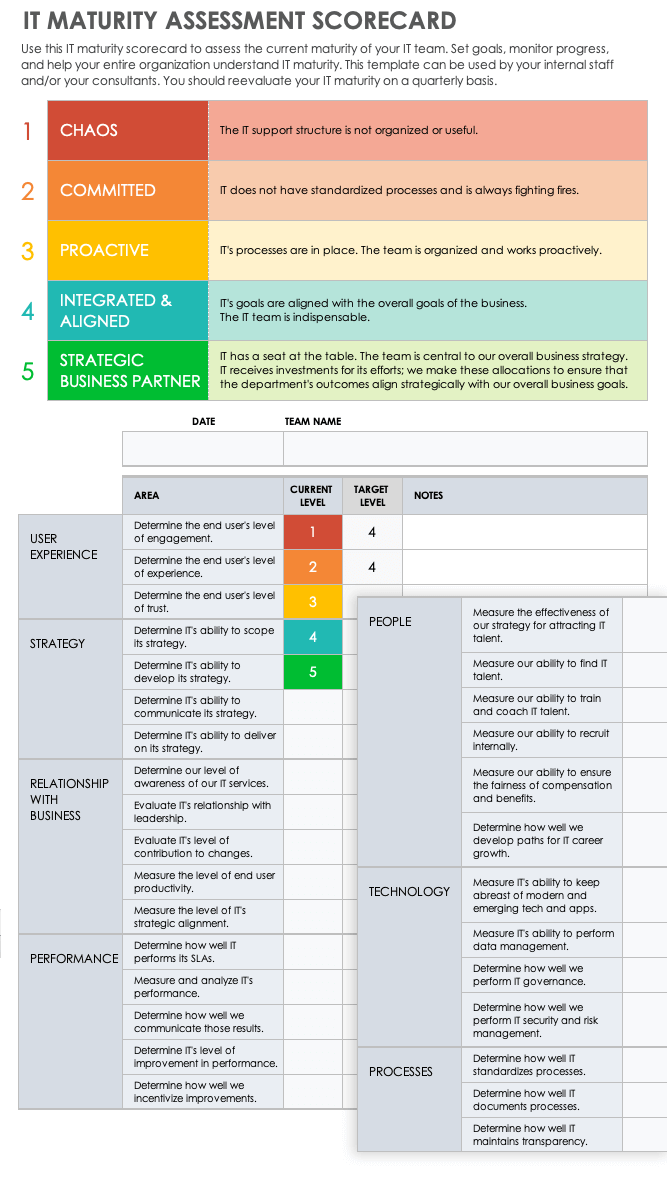What Is the Maturity Model for IT?
An IT maturity model is a tool that indicates the current development of an IT organization. IT maturity models measure the progress of people, processes, and technology. Maturity may range from low-level chaos to high-level strategic partnership.
Maturity models are common across all business disciplines. Businesses will use IT maturity models to compare where IT is today to where IT wants to be in the future. This comparison helps companies identify gaps between the current and future desired state.
Several consulting companies utilize maturity models to help IT organizations find ways to improve. The organization’s internal resource availability and budget help determine what a company uses to map current maturity and track progress. A small company may rely on surveying employees to identify IT gaps and a standard project plan to prioritize improvements. In contrast, a large enterprise may hire a consulting firm specializing in IT maturity to assess, analyze, and plan IT maturity growth.
Types of IT Maturity Models
Below are a few IT maturity models that you can use to familiarize yourself with how evaluating and scoring IT maturity works
Gartner IT Score for CIOs
Gartner’s IT Score for CIOs is one of the most popular models. This maturity model measures the maturity of key IT activities. It helps prioritize improvements and plan a path to progress.
The Gartner IT Score framework looks at functional areas, including how IT engages with leadership, strategy, innovation, IT governance, IT finance, and talent, as well as its overall performance. Each of these categories is given a high- to low-maturity rank based on how advanced the organization is in that area. Priorities are then identified based on both maturity and importance.
Forrester’s DEX Maturity Model
Forrester Consulting recently introduced the DEX maturity model, commissioned by 1E. This model evaluates the state of remote and hybrid work. The goal is to help IT improve the work experience of the digital employee.
The model contains 15 assessment questions. The questions analyze your organization’s DEX practices across four key disciplines: monitoring, security and compliance, remediation and automation, and operating model and integration.
Capability Maturity Model Integration (CMMI)
The Capability Maturity Model Integration helps a company improve its processes and behaviors. The model applies to hardware, software, and service development in any industry. The primary goal is to ensure organizations have everything necessary to develop reliable products and services.
Carnegie Mellon University in conjunction with the Department of Defense and the U.S. government developed CMMI. The model is owned by the Information Systems Audit and Control Association (ISACA) and administered by the CMMI Institute. CMMI was originally a software-specific model. Over time, it became applicable to hardware, service, and software development.
Why is IT Maturity Important?
Organizational performance depends on IT effectiveness. In turn, business excellence improves when IT can deliver good outcomes. By understanding maturity, the IT department can progress from its current state to a future desired state.
“To have a successful business, you have to secure some level of IT maturity,” says Viachaslau Matsukevich, IT Solutions Architect with CTDev. “It doesn't matter the type of company; confidence in IT is essential. A mature IT department will provide stable continuous benefits that lead to a competitive advantage, customer satisfaction, and sales growth. Neglecting IT maturity will lead to the unreliability of your services, a bad customer experience, loss of customers, and potential income.”
The capabilities that make up IT maturity for each organization will differ. Maturity is all about whether the IT department can provide the people, processes, and technology that enable a business to perform efficiently. “Highly mature organizations are less likely to have end-user disruptions. They are more likely to increase employee retention and have higher employee satisfaction. Plus, Forrester research shows that more mature organizations will have fewer security incidents and breaches,” according to Erik Jost, Chief Strategy Officer at 1E.
The IT Maturity Curve
Many IT maturity models refer to the stages of maturity as a curve. Level one is at the bottom, and level five is at the top. As IT organizations adopt people, processes, and technology improvements, they scale up the maturity curve.
What Are the Different Levels of IT Maturity?
IT maturity characterizes performance through levels or stages. Each model has its own terminology for the levels, but they all follow a similar structure. Level one is the least mature, while level five is the most mature.
Below we will define the five levels of IT maturity and what they mean for an organization.
Level 1: Chaos
Level one maturity is where an organization usually begins its IT journey. There are no processes in place. Activities, technology, and personnel are inconsistent or non-existent. The overall IT support structure is not very useful.
Level 2: Committed
Level two maturity is a bit more organized, but not enough to be proactive. The IT team still does not have processes in place. They react to issues and are always fighting fires.
Level 3: Proactive
Level three has made significant progress in maturity. Processes are in place, and documentation exists. The IT staff know their roles. The IT team can predict problems before they occur, working proactively to keep the entire organization productive.
Level 4: Integrated and Aligned
Level four IT maturity is difficult to achieve. The IT organization is beyond documenting processes and proactive problem-solving. IT and business goals are aligned. The IT organization is indispensable.
Level 5: Strategic Business Partner
In level five, IT is central to business strategy. Getting a seat at the executive table is not easy for IT because it has often been considered a cost center. Teams that reach level five receive investments for their efforts to ensure outcomes strategically align with business goals.
How to Assess IT Maturity
Assessing IT maturity involves evaluating IT's performance across all functions. You can use any model appropriate for your business. Making an assessment is not a one-time activity. It’s essential to reassess maturity to monitor progress and continually improve.
An IT maturity assessment may follow a three-step approach: assess, analyze, address. The phases are as follows:
- Assess: The assessment phase involves a series of questions or evaluators to determine the current state of a company’s IT maturity. Organizations may complete the assessment independently or with a consultant who specializes in maturity assessments. Below is an IT maturity assessment scorecard that contains guidelines for scoring IT maturity.
- Analyze: Once the assessment scorecard is complete, the results will be analyzed and will determine which IT areas require attention.
- Address: Weaknesses found during the analysis will become addressable action items. Add the action items to improve IT maturity to a project plan to create an IT improvement roadmap.
Assessing IT maturity does not need to be complex. “You can start by asking questions like: ‘What are your developers’ or operators’ level of experience? How fast can you deliver new features? What is your time to market?’ Or even questions like: ‘Can I rely on my IT department? Can I achieve the business goals using IT in a reliable and timely manner?’ Check the downtime and outages of your IT services and get feedback from within your IT department to provide visibility into pain points that could be improved,” suggests Matsukevich.
How to Improve IT Maturity
To improve IT maturity, a company must first know its current level of maturity regarding people, technology, processes, and management. Create a roadmap that takes IT from today's maturity state to the desired level and use it to guide your improvement.
It is only natural for an organization with inefficient, poor-quality IT operations to desire consistent output, standard processes, and agility. With maturity comes the ability to adjust as a business grows. The process starts with an IT maturity assessment. Once the analysis is complete, the IT team can prioritize action items for improvement. Below are tips and best practices for improving IT maturity:
- Processes: It is essential to focus on IT processes as part of your improvement strategy. “Focus on your internal processes and implement a proven best practice, such as ITIL, Scrum, or Kanban,” says Matsukevich.
Process automation is a key strategy to progressing up the maturity curve. Self-service, specifically, eases frustration and promotes business productivity. Jost shares that the legacy dependence of waiting for a service desk technician to call and conduct an intrusive screen share to resolve an issue is time-consuming and disruptive. ”The availability of self-service tools and chatbots that allow workers to circumvent the service desk admin and IT bureaucracy entirely, while resolving issues on their own time, are game changers. On the other hand, for issues that unavoidably require human assistance, service desks need to be able to act in real time with automation-driven resolution,” he says. - People: Data is key to understanding employee satisfaction (and dissatisfaction). Jost suggests gathering sentiment-driven data that paints a holistic, context-based picture of the employee experience and what matters most. “Qualitative surveys that uncover nuances between individuals can help leaders tap into employee sentiment and enact meaningful change. Change cannot occur without data and measurement," he adds.
The data you collect can feed into where to prioritize improvements. IT employees must receive training and access professional-level certifications to mature your IT organization. It is essential to create a culture where you keep your most talented IT professionals and attract new talent that will improve IT operations. “If you are having trouble hiring seasoned professionals, you can focus on growing your team internally,” says Matsukevich. “Hire fresh graduates and run them through a series of internal bootcamp training sessions that will get them up to speed quickly.” - Technology: For employees across the entire organization to perform at their optimum capacity, they require the necessary tools and the right environment to succeed. “Much like the growing demand for choice from consumers, employees want more options when it comes to workplace technology,” suggests Jost. “Employees are far more effective when they have the technology, devices, and tools that suit their preferred ways of working. Plus, IT organizations will benefit from significant cost savings by eliminating unused software and hardware.”
Download an IT Maturity Starter Kit
Get everything you need to assess your IT maturity in our IT maturity starter kit. You’ll find an IT maturity assessment scorecard and a presentation template in one easy-to-download file.
IT Maturity Assessment Scorecard Template
Download IT Maturity Assessment Scorecard Template
Microsoft Excel
| Google Sheets
The IT maturity assessment scorecard template allows you to evaluate the maturity of your IT organization. Score maturity across user experience, strategy, business relationship, and performance. Note your target maturity level and prioritize areas where gaps exist in this easy-to-use worksheet.
IT Maturity Presentation Template
Download IT Maturity Presentation Template — Microsoft PowerPoint
Use this IT maturity presentation template to provide sponsors, stakeholders, and team members with an overview of IT maturity and your team’s progress. Include criteria for each stage of IT maturity and what your team must do to achieve the desired state.
Track Your IT Maturity Level with Smartsheet
Empower your people to go above and beyond with a flexible platform designed to match the needs of your team — and adapt as those needs change.
The Smartsheet platform makes it easy to plan, capture, manage, and report on work from anywhere, helping your team be more effective and get more done. Report on key metrics and get real-time visibility into work as it happens with roll-up reports, dashboards, and automated workflows built to keep your team connected and informed.
When teams have clarity into the work getting done, there’s no telling how much more they can accomplish in the same amount of time. Try Smartsheet for free, today.



